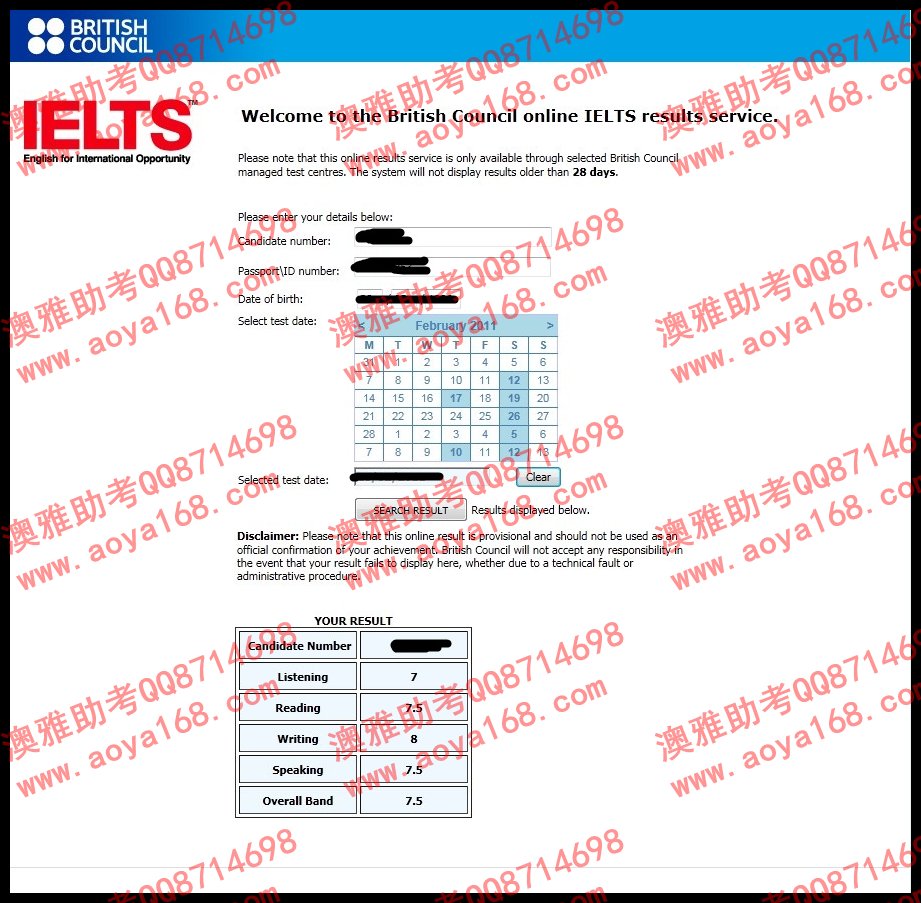澳雅助考,成功选择!
为商者,诚信根基,方可久存!
专业操作雅思,托福,GRE等出国类考试,零风险,成绩合格后付款!微信:aoya168
雅思写作7分,澳洲雅思替考,本站原创枪手写作附修正版,欢迎大家学习交流
发布:aoya168 | 分类:雅思考试 | 引用:0 | 浏览:
19 Jul 2014NO GRAPH, I WON’T BE ABLE TO RATE THIS 1
The above two charts summarise the reasons why people left the UK and stayed in the UK during the past few years.
Interestingly, the main reasons people choose to depart from the UK and live in the UK are the same,; that is to join being joining their family and friends. The percentage reaches 39% and 34% respectively. This result is not so surprising considering the important role family and friends play in our society.
On contrary, the second popular reason under each circumstance is quite different. Around 24% of people agree that they left the UK due to the weather; whereas 26% of people chose choose to stay because of the language. It is not hard to imagine these two reasons being common because on one hand, UK is famous for its cloudy, humid and foggy weather; on the other hand, English, as the world’s most widely spoken language, would attract people from all over the world, either to study the language or make a living there.
The third and fourth forth common reasons under both situations are employment and financial finance reasons, being more or less than 13% each.
Overall In conclusion , family, friends, employment and finance are the universal reasons for people to come to or leave the UK. Meanwhile, the unpleasant weather condition drives some people away and the language makes people stay advantage keeps some people continuing to stay.
HI, how are you?
I couldn’t properly asses the essay as there is no copy of the diagram; nevertheless, the vocabulary is quite good, but the essay is opinionated and this is avoided in task 1. At the end of this document is a guide as to the contents of task 1.
<--OVERALL BAND
TASK RESPONSE/TASK ACHIEVEMENT
CANNOT BE ASSESSED
6 COHERENCE & COHESION
• Data are reasonably grouped
• Transition is somewhat smooth
7 LEXICAL RESOURCE
• There is adequate vocabulary
• There are words in the wrong form
6 GRAMMATICAL RANGE AND ACCURACY
• There is a mix of structures
• There is a significant number of sentences with errors
REVISED VERSION
The changes you find here are only grammatical and mechanical. Any change in content is for you to incorporate. Ideas set in bold (if any) are the ones that need to be improved, developed, or changed.
The above two charts summarise the reasons why people left the UK and stayed in the UK during the past few years.
Interestingly, the main reasons people choose to depart from the UK and live in the UK are the same; that is to join their family and friends. The percentage reaches 39% and 34% respectively.
On contrary, the second popular reason under each circumstance is quite different. Around 24% of people agree that they left the UK due to the weather; whereas 26% of people chose to stay because of the language.
The third and fourth common reasons under both situations are employment and financial reasons, being more or less 13% each.
Overall, family, friends, employment and finance are the universal reasons for people to come to or leave the UK. Meanwhile, the unpleasant weather condition drives some people away and the language makes people stay.
Da zuo wen:
Scientists often tell people what activities are good for the health of people, while others are bad. But most people continue with unhealthy activities. Why? Solutions.
Nowadays, people can easily access scientists’ advices on healthy and unhealthy activities through various channels. However, most people still choose to stay with their unhealthy habits and are very reluctant to make changes. There are a few reasons behind this phenomenon.
The first and foremost reason why people continue unhealthy habits is that they people are lazy and tend to procrastinate most of the time. The majority of people are often comfortable with what they have been doing for years and even though they are aware of their unhealthy life pattern, there is a lack of motivation to change. For instance, nearly every ‘white collar’ in big cities admits they should do some sort of exercise after a stressful day of work. However, they may still prefer to have a relaxing night after work. In fact, the right timing and opportunity to exercise seem to be never found due to laziness.
Second, information overload could impact people’s acceptance and awareness of the information they received. It is not uncommon to have scientists telling people things are good for health and two days later these activities are overturned to be unhealthy by a different group of scientists. With millions of information to receive every day from different sources, people lost lose confidence, become indifferent to the advices, and would rather stay with old habits, which sometimes can bring no benefits to health.
Third, some young people are keen to follow their role models – namely those young Holly Wood Hollywood celebrities. Unfortunately, many celebrities maintain bad habits such as drinking, smoking and doing drugs. Juveniles are often lack of judgement and would rather follow what the stars do than listen to some ‘boring’ scientists’ advice.
Knowing this problem, there are mainly two things people can do to improve. First, stop procrastination and start doing healthy things step-by-step. For example, we know it is very healthy to drink 10 glasses of water per day but we are only having 5; we could start by drinking one more cup of water each day and keep adding up over the next few months. People shall set smaller goals and make one little improvement at a time. Second, parents should take responsibilities and help young people to live a healthy lifestyles. And also Finally, the media shall reduce the report of unhealthy habits of celebrities. The society shall make an effort to create a positive and optimistic environment for the youths.
In summary, it is not easy to stick to the healthy activities all the time because this could potentially make people step out of their comfort zones. However, if both individuals and the society as a whole can make efforts to maintain positive attitude, it is also not hard to achieve a much healthier life style.
HI, I hope you’re having a great day!
This is a commendable piece with its vocabulary fluently laid out and its grammar almost clean. Organization is also quite good. Only the introduction is problematic. Please seen the samples at the end of the document.
6.5 <--OVERALL BAND
5 TASK RESPONSE/TASK ACHIEVEMENT
• Introduction does not contain a brief response to the task
7 COHERENCE & COHESION
• Ideas are reasonably grouped
• Ideas progress through the essay
• Transition could be smoother
7 LEXICAL RESOURCE
• There is adequate range of vocabulary
• There is a few slips in word form
7 GRAMMATICAL RANGE AND ACCURACY
• There is a mix of structures
• There is frequent error free sentences.
REVISED VERSION
The changes you find here are only grammatical and mechanical. Any change in content is for you to incorporate. Ideas set in bold (if any) are the ones that need to be improved, developed, or changed.
Nowadays, people can easily access scientists’ advices on healthy and unhealthy activities through various channels. However, most people still choose to stay with their unhealthy habits and are very reluctant to make changes.
The first and foremost reason why people continue unhealthy habits is that they are lazy and tend to procrastinate most of the time. The majority of people are often comfortable with what they have been doing for years and even though they are aware of their unhealthy life pattern, there is a lack of motivation to change. For instance, nearly every ‘white collar’ in big cities admits they should do some sort of exercise after a stressful day of work. However, they may still prefer to have a relaxing night after work. In fact, the right timing and opportunity to exercise seem to be never found due to laziness.
Second, information overload could impact people’s acceptance and awareness of the information they received. It is not uncommon to have scientists telling people things are good for health and two days later these activities are overturned to be unhealthy by a different group of scientists. With millions of information to receive every day from different sources, people lose confidence, become indifferent to the advices, and would rather stay with old habits, which sometimes can bring no benefits to health.
Third, some young people are keen to follow their role models – namely those young Hollywood celebrities. Unfortunately, many celebrities maintain bad habits such as drinking, smoking and doing drugs. Juveniles often lack of judgement and would rather follow what the stars do than listen to some ‘boring’ scientists’ advice.
Knowing this problem, there are mainly two things people can do to improve. First, stop procrastination and start doing healthy things step-by-step. For example, we know it is very healthy to drink 10 glasses of water per day but we are only having 5; we could start by drinking one more cup of water each day and keep adding up over the next few months. People shall set smaller goals and make one little improvement at a time. Second, parents should take responsibilities and help young people to live a healthy lifestyles. Finally, the media shall reduce the report of unhealthy habits of celebrities. The society shall make an effort to create a positive and optimistic environment for the youths.
In summary, it is not easy to stick to healthy activities all the time because this could potentially make people step out of their comfort zones. However, if both individuals and the society as a whole can make efforts to maintain positive attitude, it is also not hard to achieve a much healthier life style.
Good luck!
Tip for the day
How do I answer an IELTS writing task 1?
To analyse this, we’ll look at a line graph. Look at the following question and the graph.
You should spend about 20 minutes on this task.
The line graph below shows changes in the amount and type of fast food consumed by Australian teenagers from 1975 to 2000.
Summarize the information by selecting and reporting the main features and make comparisons where relevant.
Write at least 150 words.
There are three basic things you need to structure an IELTS writing task 1.
1. Introduce the graph
2. Give an overview
3. Give the detail
We’ll look at each of these in turn.
1) Introduce the Graph
You need to begin with one or two sentences that state what the IELTS writing task 1 shows. To do this, paraphrase the title of the graph, making sure you put in a
time frame if there is one.
Here is an example for the above line graph:
The line graph illustrates the amount of fast food consumed by teenagers in Australia between 1975 and 2000, a period of 25 years.
You can see this says the same thing as the title, but in a different way.
2) Give an Overview
You also need to state what the main trend or trends in the graph are. Don’t give detail such as data here – you are just looking for something that describes what is happening overall.
One thing that stands out in this graph is that one type of fast food fell over the period, whilst the other two increased, so this would be a good overview.
Here is an example:
Overall, the consumption of fish and chips declined over the period, whereas the amount of pizza and hamburgers that were eaten increased.
This covers the main changes that took place over the whole period.
You may sometimes see this overview as a conclusion. It does not matter if you put it in the conclusion or the introduction when you do an IELTS writing task 1, but you should provide an overview in one of these places.
3) Give the Detail
You can now give more specific detail in the body paragraphs.
When you give the detail in your body paragraphs in your IELTS writing task 1, you must make reference to the data.
The key to organizing your body paragraphs for an IELTS writing task 1 is to group data together where there are patterns.
To do this you need to identify any similarities and differences.
Look at the graph – what things are similar and what things are different?
As we have already identified in the overview, the consumption of fish and chips declined over the period, whereas the amount of pizza and hamburgers that were eaten increased.
So it is clear that pizza and hamburgers were following a similar pattern, but fish and chips were different. On this basis, you can use these as your ‘groups’, and focus one paragraph on fish and chip and the other one on pizza and hamburgers.
Here is an example of the first paragraph:
In 1975, the most popular fast food with Australian teenagers was fish and chips, being eaten 100 times a year. This was far higher than pizza and hamburgers, which were consumed approximately 5 times a year. However, apart from a brief rise again from 1980 to 1985, the consumption of fish and chips gradually declined over the 25 year timescale to finish at just under 40 times per year.
As you can see, the focus is on fish and chips. This does not mean you should not mention the other two foods, as you should still make comparisons of the data as the questions asks.
The second body then focuses on the other foods:
In sharp contrast to this, teenagers ate the other two fast foods at much higher levels. Pizza consumption increased gradually until it overtook the consumption of fish and chips in 1990. It then leveled off from 1995 to 2000. The biggest rise was seen in hamburgers, increasing sharply throughout the 1970’s and 1980’s, exceeding fish and chips consumption in 1985. It finished at the same level that fish and chips began, with consumption at 100 times a year.
Full Model Answer:
The line graph illustrates the amount of fast food consumed by teenagers in Australia between 1975 and 2000, a period of 25 years. Overall, the consumption of fish and chips declined over the period, whereas the amount of pizza and hamburgers that were eaten increased.
In 1975, the most popular fast food with Australian teenagers was fish and chips, being eaten 100 times a year. This was far higher than Pizza and hamburgers, which were consumed approximately 5 times a year. However, apart from a brief rise again from 1980 to 1985, the consumption of fish and chips gradually declined over the 25 year timescale to finish at just under 40 times per year.
In sharp contrast to this, teenagers ate the other two fast foods at much higher levels. Pizza consumption increased gradually until it overtook the consumption of fish and chips in 1990. It then leveled off from 1995 to 2000. The biggest rise was seen in hamburgers, increasing sharply throughout the 1970’s and 1980’s, exceeding fish and chips consumption in 1985. It finished at the same level that fish and chips began, with consumption at 100 times a year.
(191 words)
Pasted from
Children are often pressure. What are the reasons? How can we solve this?
[hook] Pressure nowadays is no longer unique to adults for even children experience such. [elaborate] There is pressure in school, in relationships, and even in ownership of things. [answer to question 1] Such pressure is evidently brought about by children’s desire to be accepted by their friends and to have a brighter future, [answer to question 2] and could therefore be diminished if children are taught the value of contentment.
[topic sentence] Everyone would want to fit in and later have a good future, even adults. [detail] But the pressure is stronger for children since, unlike adults who already have qualifications to prove their worth, children are still finding their place in society at present and their possible careers in the future. [example] To be accepted by society, they tend to give in to what their peers ask of them even it if it against their morals. [example]Furthermore, to be a productive member of society in the future, children are forced to do excellently in school, thereby setting aside their childish needs. [example] Finally, commercialism and the introduction of too many luxurious goods in the market add even more pressure as children would naturally want to own things that their friends have. [closing]Thus, pressure among children is brought about by their utmost desire to be accepted and to fit in their present and future social circles.
[topic sentence] Yet, children only get the idea that they have to fit in and design a better future because this is what their family and other people of society are telling them to do. [detail] If these children are taught to be contented with what they have, then commercial pressure would be eliminated. [detail] If they are taught how to develop their own personality, then they don’t have to give in to social pressure. Finally, [detail] if they are taught how to enjoy learning, and not how it is useful in the future, then they would be more relaxed when studying. [closing]Pressure in children is easily resolved if adults set good examples.
In the end, since it is the adults who have set too high expectations on children, it is only them who can eliminate the pressure. Children are in the stage of exploration and fun; thus, pressure is not something that they should be experiencing.
Children find it difficult to concentrate on or pay attention to school. What are the reasons? How can we solve this problem?
Concentration is very important in studying, but nowadays, with the many technologies that children are exposed to, paying attention in school is becoming even more difficult. To resolve such issues, children’s use of technology should be moderated.
The internet, mobile phones, and other gadgetries are distractions to studying. Such technologies have captured children attention so much that they spend hours using it. A few of the nieces and nephews spend hours chatting online, some are always fidgeting with their mobile phones, most of them almost deprive themselves of sleep just to play the Xbox. So much is their exposure that even the time they need for studying is consumed. They fail to do their homework, and worse, the sleep in class. One of my nephews, who is a straight A student, recently lost his post in the honor roll as he suddenly became addicted to the Xbox and there’s nothing much he talk about apart from it. His school performance has been greatly affected as his attention slowly diverted from studying to playing.
Yet, such issue is not difficult to address. Parents will just have to moderate children’s use of technology, while teachers could be more creative and help students use such technologies in a more educationally beneficial manner. For one, this nephew of mine whose name was dropped from the honor roll have parents who are too busy to even take notice of him. Thus, there is no one in their home to actually call his attention and so he does as he pleases. If his parents could take time to talk with him then they could come to an agreement to balance studying and playing. Meanwhile, teachers could probably stop addressing technology as nuances; instead, they ought to encourage students to use such technology more particularly to gain knowledge, like the internet for research, and android phones for educational applications like language applications and e-books. Games on Xbox, on the other hand, could be promoted as a way to enhance critical thinking and strategic problem solving.
In the end, technology, though a definite distraction from studying, could be otherwise helpful and seen from a different perspective. Parents will have to take time in dealing with their children’s moderation of technological use while teachers reinforce positive side of such technologies. In this manner, children will still get to do what they enjoy without having to lose focus on their studies.
- 相关文章:
本站新推出雅思写作7分,雅思替考 枪手,批改,再给修正版本,也希望大家提供范文,提供免费批改,请联系QQ8714698 (2014-7-9 7:46:5)
雅思写作7分,雅思枪手,雅思替考四个7分,这篇写作放在中国,只有6-6.5分,放在其他国家,至少6.5-7分 (2014-6-28 20:23:17)
这篇雅思作文徘徊在雅思写作7分左右,遇到可爱点老师7分,遇到搞点的老师可能就6.5,大家交流学习吧 ! (2014-6-8 6:34:31)
本站又一原创力作,雅思写作7分,雅思枪手 雅思代考,澳雅助考 (2014-5-18 20:15:35)
考生必读,教你如何找靠谱的代考 (2014-5-2 9:25:57)
本站唯一推出一篇手抄本雅思写作7分,真刀实枪,这才是实力,雅思四个7分,一直坚持,从未懈怠! (2014-4-21 0:55:11)
本站推出一篇,一个大美女的佳作,雅思四个7分,写作7分,大家学习交流 (2014-4-17 5:50:30)
本站原创,又推出一篇雅思写作7分,雅思代考,雅思替考,雅思枪手四个7分,欢迎交流 (2014-4-1 10:15:12)
招兵买马,招贤纳士,有英语高手的请进 (2014-3-8 8:40:41)
本站又推出一篇雅思写作7分,一个小男孩写的,大家学习交流(本站原创) (2014-3-8 8:38:29)
发表评论
◎欢迎参与讨论,请在这里发表您的看法、交流您的观点。




0评论 - 雅思写作7分,澳洲雅思替考,本站原创枪手写作附修正版,欢迎大家学习交流